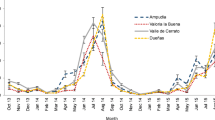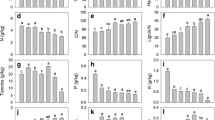Abstract
The aim of this study was to assess how the physical (needle fragmentation by trampling) and chemical (nutritional enrichment from faeces) changes brought about by grazing influence the consumption of needles of Pinus pinea L. by Ommatoiulus sabulosus L. Adult individuals of O. sabulosus were introduced into trays with pine needles subjected to four treatments: (i) intact needles, (ii) trampled needles, (iii) intact needles fertilized with liquid manure, and (iv) trampled needles fertilized with liquid manure. After 30 days, litter decomposition was determined as a function of mass loss over time. Biometric and chemical characteristics of the needles were also measured. The pine needle decomposition rate was significantly higher in the presence of O. sabulosus (20–40%) than in its absence, presenting in addition a significantly higher rate in the treatments enriched with nitrogen. Average needle length was significantly shorter in the trampled treatments (6.89 ± 0.50 cm) than in those with intact needles (11.95 ± 0.69 cm). With regard to leaf mass per area and resistance to breakage, no significant differences were found. The fertilized treatments presented significantly higher N content (50% higher) than those in the non-fertilized ones with a significantly lower C:N ratio. The results of the present study indicate that goat grazing (which produces both trampling and fertilization) favoured the consumption of pine needles by O. sabulosus, which thus influences, along with the microbial community, the decomposition rate of these needles and thereby promotes incorporation of N into the system.


Similar content being viewed by others
References
Aerts R (1997) Climate, leaf litter chemistry and leaf litter decomposition in terrestrial ecosystems: a triangular relationship. Oikos 79:439–449
Akkari N, Enghoff H (2012) Review of the genus Ommatoiulus in Andalusia, Spain (Diplopoda: Julida) with description of ten new species and notes on a remarkable gonopod structure, the fovea. Zootaxa 3538:1–53
Arnebrant K, Bååth E, Söderström B (1990) Changes in microfungal community structure after fertilization of Scots pine forest soil with ammonium nitrate or urea. Soil Biol Biochem 22:309–312
Baas M, Cherett JM (1995) Leaf-cutting ants (Formicidae, Attini) prune their fungus to increase and direct its productivity. Funct Ecol 10:55–61
Bååth E, Arnebrant K (1993) Microfungi in coniferous forest soils treated with lime or wood ash. Biol Fertil Soils 26:995–1001
Bardgett RD, Wardle DA (2003) Herbivore-mediated linkages between aboveground and belowground communities. Ecology 84:2258–2268
Bardgett RD, Wardle DA (2010) Aboveground-belowground linkages: biotic interactions, ecosystem processes, and global change. Oxford University Press, Oxford
Bardgett RD, Wardle DA, Yeates GW (1998) Linking aboveground and below-ground interactions: how plant responses to foliar herbivory influence soil organisms. Soil Biol Biochem 30:1867–1878
Bazely DR, JeVeries RL (1985) Goose faeces: a source of nitrogen for plant growth in a grazed salt marsh. J App Ecol 22:693–703
Berg B, McClaugherty C, Santo AVD, Johnson D (2001) Humus buildup in boreal forests: effects of litter fall and its N concentration. Canad J For Res 31:988–998
Bonkowski M, Scheu S, Schaefer M (1998) Interactions of earth-worms (Octolasion lacteum), millipedes (Glomeris marginata) and plants (Hordelymus europaeus) in a beechwood on a basalt hill: implications for litter decomposition and soil formation. Appl Soil Ecol 9:161–166
Bryant JP, Provenza FD, Pastor J, Reichardt PB, Clausen TP, Du Toit JT (1991) Interactions between woody plants and browsing mammals mediated by secondary metabolites. Ann Rev Ecol Systs 22:431–446
Chapin FS III, Matson PA, Vitousek PM (2011) Principles of terrestrial ecosystem ecology. Springer Science & Business Media, New York
Coleman DC, Crossley DA Jr, Hendrix PF (2004) Fundamentals of soil ecology. Elsevier Academic Press, Amsterdam
Coulis M, Hättenschwiler S, Fromin N, David JF (2013) Macroarthropod-microorganism interactions during the decomposition of Mediterranean shrub litter at different moisture levels. Soil Biol Biochem 64:114–121
Couteaux MM, Bottner P, Berg B (1995) Litter decomposition, climate and litter quality. Trends Ecol Evol 2:63–66
David JF (1999) Abundance, biomass and functional structure of the saprophagous macrofauna in the litter and soil of Mediterranean oak forests. Pedobiologia 43:319–327
David JF, Devernay S, Loucougaray G, Le Floc’h E (1999) Belowground biodiversity in a Mediterranean landscape: relationships between saprophagous macroarthropod communities and vegetation structure. Biodivers Conserv 8:753–767
Dubeux JCB, Sollenberger LE, Interrante SM, Vendramini JMB, Stewart RL (2006) Litter decomposition and mineralization in bahia grass pastures managed at different intensities. Crop Sci 46:1305–1310
Dyer MI, Turner CL, Seastedt TR (1991) Mowing and fertilizing effects on productivity and spectral reflectance in Bromus inermis plots. Ecol Appl 1:559–564
Frank DA, Groffman PM, Evans RD, Tracy BF (2000) Ungulate stimulation of nitrogen cycling and retention in Yellowstone Park grasslands. Oecologia 123:116–121
Gallardo A, Merino J (1993) Leaf decomposition in two Mediterranean ecosystems of southwest Spain: influence of substrate quality. Ecology 74:152–161
Garibaldi LA, Semmartin M, Chaneton EJ (2007) Grazing induced changes in plant composition affect litter quality and nutrient cycling in flooding Pampa grasslands. Oecologia 151:650–662
Gillon D, Jofre R, Ibrahamina A (1994) Initial litter properties and decay rates: a microcosm experiments on Mediterranean species. Can J Bot 72:946–954
Hargrave BT (1972) Prediction of egestion by the deposit-feeding amphipod Hyalella azteca. Oikos 23:116–124
Harmon ME, Silver WL, Fasth B, Chen H, Burke IC, Parton WJ, Hart SC, Currie WS, LIDET (2009) Long-term patterns of mass loss during decomposition of leaf and fine root litter: an intersite comparison. Glob Change Biol 15:1320–1338
Haynes RJ, Williams PH (1999) Influence of stock camping behaviour on the soil microbiological and biochemical properties of grazed pastoral soils. Biol fertil soils 28:253–258
Hobbie SE (1996) Temperature and plant species control over litter decomposition in Alaskan tundra. Ecolog Monogr 66:503–522
Holland EA, Parton WJ, Detling JK, Coppock DL (1992) Physiological responses of plant populations to herbivory and their consequences for ecosystem nutrient flow. Am Nat 4:685–706
Holland JN, Chenge W, Crossley DA (1996) Herbivore-induced changes in plant carbon allocation: assessment of below-ground C fluxes using carbon-14. Oecologia 107:87–94
Joffre R, Ågren GI, Gillon D, Bosatta E (2001) Organic matter quality in ecological studies: theory meets experiment. Oikos 93:451–458
Kadamannaya BS, Sridhar KR (2009) Leaf litter ingestion and assimilation by two endemic pill millipedes (Arthrosphaera). Biol Fertil Soils 45:761–768
Kooijman AM, Smit A (2001) Grazing as a measure to reduce nutrient availability and plant productivity in acid dune grasslands and pine forests in The Netherlands. Grass Sci 17:63–77
Latrou GD, Stamou GP (1991) The life cycle and spatial distribution of Glomeris balcanica (Diplopoda, Glomeridae) in an evergreen-sclerophyllous formation in northern Greece. Pedobiologia 35:1–10
Lavelle P, Spain AV (2001) Soil ecology. Kluwer Academic, Dordrecht
Li X, Han S, Zhang Y (2007) Foliar decomposition in a broadleaf-mixed Korean pine (Pinus koraiensis Sieb. Et Zucc) plantation forest: the impact of initial litter quality and the decomposition of three kinds of organic matter fraction on mass loss and nutrient release rates. Plant Soil 295:151–167
Liu K, Sollenberger LE, Silveira ML, Vendramini JMB, Newman YC (2011) Grazing intensity and nitrogen fertilization affect litter responses in ‘Tifton 85’ bermudagrass pastures: II. Decomposition and nitrogen mineralization. Agron J 103:163–168
Mancilla-Leytón JM, Sánchez-Lineros V, Martín Vicente A (2013a) Influence of grazing on the decomposition of Pinus pinea L. needles in a silvopastoral system in Doñana, Spain. Plant Soil 373:173–181
Mancilla-Leytón JM, Pino Mejías R, Martín Vicente A (2013b) Do goats preserve the forest? Evaluating the effects of grazing goats on combustible Mediterranean scrub. App Veg Sci 16:63–73
Maraun M, Scheu S (1996) Changes in microbial biomass, respiration and nutrient status of beech (Fagus sylvatica) leaf litter processed by millipedes (Glomeris marginata). Oecologia 107:131–140
Matus FJ, Rodríguez J (1994) A simple model for estimating the contribution of nitrogen mineralization to the nitrogen supply of crops from a stabilized pool of soil organic matter and recent organic input. Plant Soil 162:259–271
McIntire EJB, Hik DS (2002) Grazing history versus current a grazing: leaf demography and compensatory growth of three alpine plants in response to a native herbivore (Ochotona collaris). J Ecol 90:348–359
McNaughton SJ (1985) Ecology of a grazing ecosystem: the Serengeti. Ecol Monogr 55:259–294
Moro MJ, Domingo F (2000) Litter decomposition in four woody species in a Mediterranean climate: weight loss, N and P dynamics. Ann Bot 86:1065–1071
Odum EP, de la Cruz AA (1967) Particulate organic detritus in a Georgia salt marsh-estuarine system. In: Lauff GH (ed) Estuaries, vol 83. American Association for the Advancement of Science Publication, Washington, DC, pp 383–388
Olofsson J, Oksanen L (2002) Role of litter decomposition for the increased primary production in areas heavily grazed by reindeer: a litterbag experiment. Oikos 96:507–515
Pastor J, Naiman RJ (1992) Selective foraging and ecosystem processes in boreal forests. Am Nat 4:690–705
Pausas JG (1997) Litter fall and litter decomposition in Pinus sylvestris forests of the eastern Pyrenees. J Veg Sci 8:643–650
Pennanen T, Liski J, Bååth E, Kitunen V, Uotila J, Westman CJ, Fritze H (1999) Structure of the microbial communities in coniferous forest soils in relation to site fertility and stand development stage. Microb Ecol 38:168–179
Proulx M, Mazumder A (1998) Reversal of grazing impact on plant species richness in nutrient-poor versus nutrient-rich ecosystems. Ecology 79:2581–2592
Ritchie ME, Tilman D, Knops JM (1998) Herbivore effects on plant and nitrogen dynamics in oak savanna. Ecology 79:165–177
Ruess WR, McNaughton SJ (1987) Grazing and the dynamics of nutrient and energy regulated microbial processes in the Serengeti grasslands. Oikos 49:101–110
Scheu S, Parkinson D (1994) Effects of earthworms on nutrient dynamics, carbon turnover and microorganisms in soils from cool temperate forests of the Canadian Rocky Mountains laboratory studies. App Soil Ecol 1:113–125
Scheu S, Schlitt N, Tiunov AV, Newington JE, Jones TH (2002) Effects of the presence and community composition of earthworms on microbial community functioning. Oecologia 133:254–260
Silver W, Miya R (2001) Global patterns in root decomposition: comparisons of climate and litter quality effects. Oecologia 129:407–419
Sirotnak JM, Huntly NJ (2000) Direct and indirect effects of herbivores on nitrogen dynamics: voles in riparian areas. Ecology 81:78–87
Swift MC (1976) Energetics of vertical migration in Chaoborus trivittatus larvae. Ecology 57:900–914
Tajovský K, Šantrůčková H, Hánĕl L, Balík LA (1992) Decomposition of faecal pellets of the millipede Glomeris hexasticha (Diplopoda) in forest soil. Pedobiologia 36:146–158
Vanlauwe B, Sanginga N, Merckx R (1997) Decomposition of four Leucaena and Senna prunings in alley cropping systems under subhumid tropical conditions: the process and its modifiers. Soil Biol Biochem 29:131–137
Visser S (1985) Role of the soil invertebrates in determining the composition of soil microbial communities. In: Fitter AH, Atkinson D, Read DJ, Usher MB (eds) Ecological interactions in soil. Special publication No. 4. British Ecological Society. Blackwell, Oxford, pp 297–317
Wang QS, Huang Y (2008) Comparisons of litter fall, litter decomposition and nutrient return in a monoculture Cunninghamia lanceolata and a mixed stand in southern China. For Ecol Manag 255:1210–1218
Wilson JB, Agnew ADQ (1992) Positive-feedback switches in plant communities. Adv Ecol Res 23:263–336
Wolters V (2000) Invertebrate control of soil organic matter stability. Biol Fertil Soils 3:1–19
Zimov SA, Chuprynin VI, Oreshko AP, Chapin FS III, Reynolds JF, Chapin MC (1995) Steppe-tundra transition: a herbivore-driven biome shift at the end of the Pleistocene. Am Nat 146:765–794
Acknowledgements
This study was funded by the Consejería de Medio Ambiente (Junta de Andalucía) (OG-052/07). The authors wish to thank Doñana Natural Park and Dehesa de Gatos S.L. for the logistic support and field facilities. The authors also thank Dr. Pérez-Ramos and Dra. Muñoz-Vallés for their useful comments on the earlier version of this manuscript. The useful field and laboratory assistance by Cristina Palomares is also acknowledged. A. Serrano checked the language grammar of this paper. J.M. Mancilla-Leytón gratefully acknowledges the receipt of a Postdoctoral Research Contract (V Plan Propio de Investigación de la Universidad de Sevilla, Ref. II.5.B/2015).
Author information
Authors and Affiliations
Corresponding author
Additional information
Communicated by Lesley Rigg.
Rights and permissions
About this article
Cite this article
Mancilla-Leytón, J.M., Cambrollé, J. & Martín Vicente, A. A multitrophic interaction: consequences of grazing on decomposition of needles of Pinus pinea L. by Ommatoiulus sabulosus L.. Plant Ecol 218, 241–249 (2017). https://doi.org/10.1007/s11258-016-0679-5
Received:
Accepted:
Published:
Issue Date:
DOI: https://doi.org/10.1007/s11258-016-0679-5




